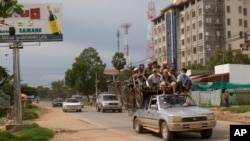The International Monetary Fund (IMF) aired concerns last week over the mounting concentration of bank credit in the real estate and construction sectors while projecting the country’s annual economic growth at 7.25 percent this year.
The IMF did not provide a breakdown of the exact share of the country’s overall credit balance held by the real estate and construction sectors.
“Bank credit, increasingly concentrated in the real estate market and construction sectors, is expected to grow around 20 percent in 2018,” said Jarkko Turunen, who led the IMF’s team to conduct its annual Cambodia consultation.
“Concerns about credit quality, external funding, increasing concentration in the real estate sector and unregulated lending by real estate developers, and high credit growth and growing systemic importance of microfinance institutions (MFI) continue to pose risks to financial and macroeconomic stability,” Turunen added in a press conference in Phnom Penh on Tuesday.
Although the central bank had stepped in to ensure financial stability, including encouraging capital conservation buffers, liquidity control schemes, and making partial changes to the loan-provision process, more needs to be done, the IMF expert said.
“This includes effective implementation of past measures, further targeted prudential measures, such as risk weights for real-estate lending, an introduction of a crisis management framework with a deposit insurance scheme, and continued upgrading in regulation and supervision, including for non-bank financial institutions.”
Ngeth Chou, an independent financial consultant, echoed the IMF’s concerns, saying that oversupply in the real estate sector could lead to a crisis in the future.
“Two things can be done here in general: Firstly, a regulation which means increased controls on loan-providing. Secondly, financial literacy among the populace in managing their assets, resources, and loans to create income,” Chou said.
Acleda Bank President In Channy said that he believed the IMF’s projection of 20-percent credit growth this year was a moderate figure compared with previous rises. He declined to comment on real estate loan concerns, citing the lack of exact figures provided by the IMF.
In Channy said in 2008 the National Bank of Cambodia capped commercial bank housing loans of more than 15 percent of the total credit in each bank. “For Acleda, housing loans amount to only 8 percent of its overall $3.27 billion credit,” he told VOA Khmer.
Yun Sovanna, Executive Director of the Cambodian Microfinance Association, said it is understandable that the “systemic importance” of microfinance institutions “should be paid attention to.”
“We’re not yet in a ‘too big to fail’ kind of scenario as a sector. But we acknowledge with MFI total assets of GDP reaching almost 20 percent, [MFIs] have grown to be even more important than they used to be and this requires attention from both a regulatory perspective and by the MFIs themselves,” he said.
But the Cambodian Microfinance Association has taken a self-regulatory approach for its members to improve credit quality, including increased repayability assessment, enhanced competition environment, and client protection measures, Sovanna said.
Many families in rural Cambodia have taken microloans over the past several years.
The national bank’s director-general, Chea Serey, could not be immediately reached for comment.
The annual inflation rate is forecast by the IMF to stay at 2.5 percent this year -- a figure comparable to that of the estimates of the Asian Development Bank, which revised down last week its inflation estimate from 3.2 percent to 2.6 percent for 2018.







